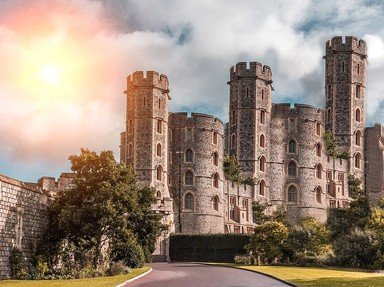Quiz Answer Key and Fun Facts
1. Hastings Castle, built by William the Conqueror on the cliff above where he first landed, thrived until disaster struck in the 1300s. What happened to it?
2. The ancient hillfort between Salisbury and Stonehenge was the site both of the ancient city and the old cathedral. Now, only a few stone walls and foundations remain (well, there's an excellent view, too). What name is now used for this hillfort?
3. For a ruin, Portchester Castle is in pretty good shape. Sure, most of the rooms are now roofless (and in many cases wall-less), but you can still go all the way to the top of the keep and look out over what city?
4. Here's one that may stretch the definition of 'castle', but is awe-inspiring nonetheless. First fortified some 5000 years ago and held by the Celts until finally captured by Vespasian (a future Roman emperor), this Dorset county hillfort has no walls. Instead it has earthen ramparts, carved out of the hillside to form imposing defenses. (Very impressive in an age without bulldozers!) What is the name of this fortification?
5. If you go down into the crypt of York Minster (another word for a cathedral), you will find layers of archaeological detritus neatly labeled for your perusal. Among them are Roman gravestones and pottery, as well as a still-functional Roman culvert into which you can peek and see the water flow. It turns out that the Minster was built on the old site of a Roman military headquarters -- in fact, the very fortification where what man was first proclaimed emperor?
6. Now let's deal with a different type of 'castle ruin': the ruined castle. Warwick Castle, a Norman fortress built on a site first fortified by Alfred the Great's daughter Ethelfleda, is rather less ruined than many of the other buildings featured in this quiz. It helped that it was the seat of an important earldom! Nevertheless, in 1978 it passed out of private ownership and into the hands of what company?
7. To depart from castles briefly: Battle Abbey was a monastery built on the site of the Battle of Hastings (1066) by William the Conqueror. When Henry VIII decided not to be Catholic anymore, he let loose his minions on the monasteries and abbeys and convents, confiscating all manner of valuables and turning Battle Abbey into a full-fledged ruin (no second floor, only the foundations of the nave, a staircase going to nowhere, etc.). But, back when it was first built, the High Altar was placed on the spot where what Saxon king was said to have been killed by William's forces?
8. Back to castles. Leeds Castle, 'the most beautiful castle in England', is nowhere near Leeds the city, and is generally considered to be in pretty good condition and not a ruin at all. Yet one part of it, just outside the drawbridge but still fortified, IS a ruin. This small outbuilding served what purpose, vital during a siege?
9. The Tower of London is not a ruin, nor is it likely to soon become one (it brings in too much tourist money), but in the middle of it lies a small section of ruined wall said to part of the original Roman fortification of what city, the precursor of London?
10. The moment of truth: Can I come up with one more question? This category will be the ruin of me!! (Heh, heh, heh). Well, here goes. Canterbury still has its medieval walls (well, most of them), built on the ruins of the Roman walls. It does not, however, still have most of its gates. The West Gate, best (maybe only) of the survivors, is now a museum, but it used to serve what other purpose?
Source: Author
CellarDoor
This quiz was reviewed by FunTrivia editor
Bruyere before going online.
Any errors found in FunTrivia content are routinely corrected through our feedback system.

